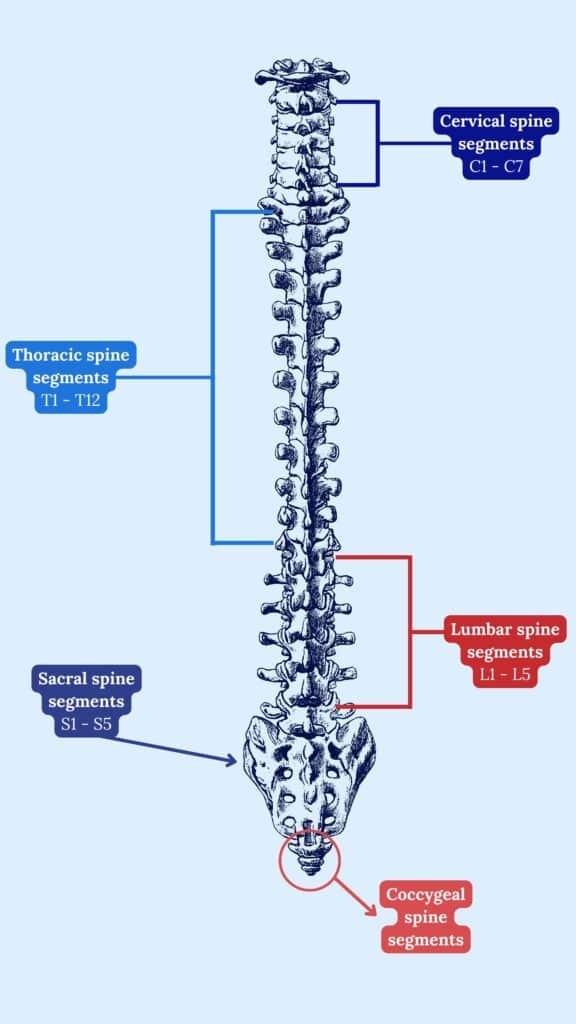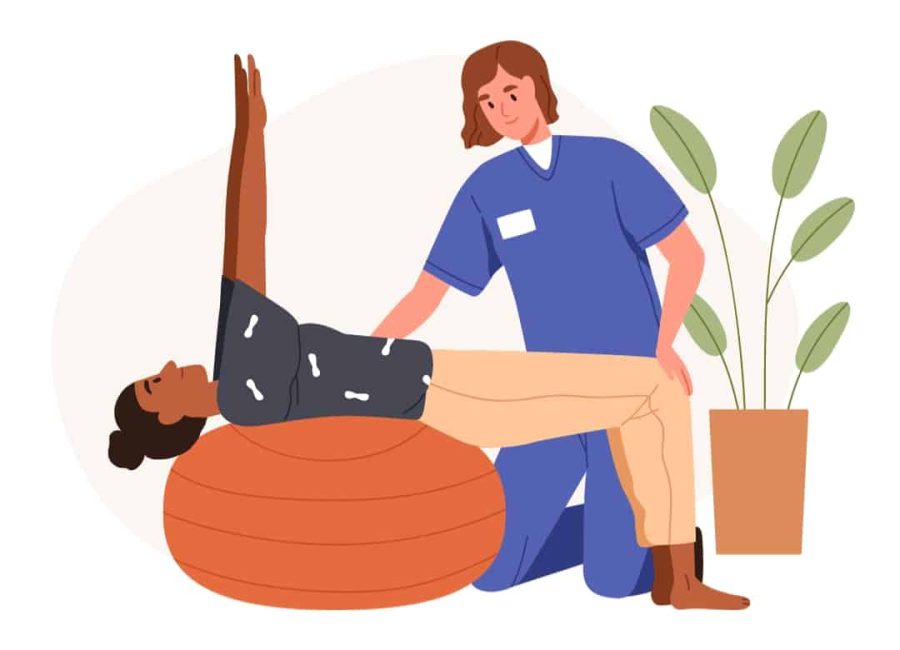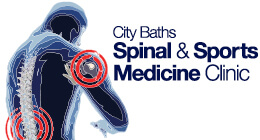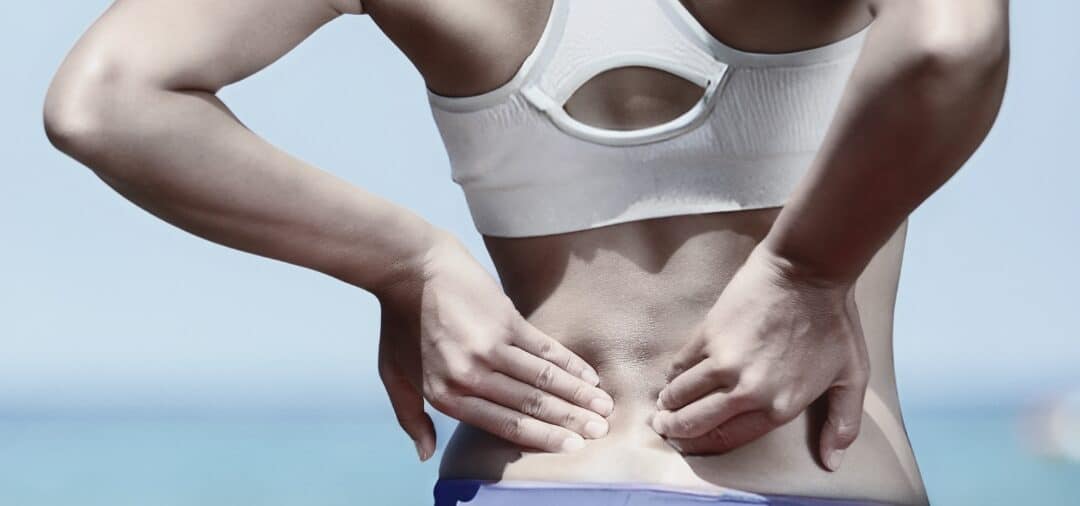
Low back pain (LBP) is one of the most common musculoskeletal problems treated by primary care providers (e.g. GP, physiotherapists, osteopaths, etc.) and affects between 1 in 4 and 1 in 7 Australians at any time.
In this blog we will aim to help you understand some of the different causes of low back pain, how it is diagnosed, and how it’s managed through various physiotherapy techniques.
We will also aim to debunk some common myths and misconceptions relating to LBP.
The Spine:
Your spine is a complex structure. It supports your body weight and allows you to move freely. It is also home to your spinal cord, which carries messages between your brain and the rest of your body.
Understanding how the spine is built can help you to make sense of some of the causes of LBP.
Structure of the Spine:

Our spine is made up of bony segments called vertebrae. The vertebrae consist of a main body and bony segments coming off the body.
Each vertebrae forms important joints and columns with its adjacent vertebrae. The vertebrae are stacked vertically and form a bony column which houses and protects the spinal cord.
Between each of the vertebral bodies, we have a spongy segment called intervertebral discs. These discs act as shock absorbers.
The vertebrae are covered in ligaments (tough bands of soft connective tissue) and muscles to support them.
The bony structure, ligaments and muscles of the spine give it strength, stability, and movement.

Our Spine is made up of 5 segments:

- Cervical spine (neck) – the cervical spine is what we call the spinal segment making up your neck. It is made up of 7 vertebrae: C1-C7.
- Thoracic spine (mid-back) – situated below the cervical vertebrae, this spinal segment attaches to your ribs to form your ribcage. This segment is composed of 12 vertebrae: T1-T12.
- Lumbar spine (lower back) – the lower portion of your spine. When people refer to LPB, they are usually experiencing pain in their lumbar region. The lumbar spine is made up of 5 vertebrae L1-L5.
- Sacrum – a triangular portion that lies in the pelvis and made up of 5 fused vertebrae: S1-S5.
- Coccyx (tailbone) – commonly known as the ‘tailbone’, the Coccyx is made up of 4 vertebrae, which are fused together.
Low back pain causes:
Low back pain/lower back pain, refers to pain occurring in the lumbar segment of the spine and its surrounding tissues.
Currently, LBP is separated into two broad categories.
1. Non-specific low back pain
The term ‘non-specific’ is used where there is no specific illness, injury or disease that is causing the pain. This accounts for 90-95% of cases. Although this sounds vague and frustrating, there are many structures in the back that can cause pain (e.g. bones, nerves, soft tissue, joints.), which cannot be identified in a scan. Furthermore, back pain is often caused by a combination of different factors, rather than an individual structure in the back.
Some things that may contribute to this type of pain can include:
- Muscular strains
- Ligament sprains
- Poor sleep
- Smoking
- Depression or anxiety

- Lack of exercise
- Sudden increase in load (e.g. going on holiday and carrying heavy luggage more than usual)
- Obesity
If the pain has been present for less than 3 months, we refer to this as acute low back pain. If it is longer than 3 months, it is referred to as chronic or persistent low back pain.
2. Specific LBP:
This category of low back pain has a specific disease or injury that is causing the pain.
- Inflammatory arthritis e.g. ankylosing spondylitis
- Fracture e.g. after an accident
- Herniated disc
- Cauda equina Syndrome (damage to or irritation of the bundle of nerves found immediately below our spine)
- Infection *
- Cancer *
It’s important to note the above conditions are very rare and account for 5-10% of back pain cases.
*Infection and cancer account for less than 1% of cases
Diagnosis
Your healthcare professional will ask you questions about your pain, any potential triggers, whether you’ve had similar pain in the past, and questions about your general health and wellbeing. They will also do a physical examination.
Do I need a scan?
Scans such as X-rays, MRIs and CTs are often not necessary for LBP unless there is suspicion of a specific injury or illness. In most cases, scans:
- Cannot find a direct cause of pain.
- Do not change management/treatment strategies.
- Can be costly.
Your healthcare professional can make an imaging referral if it is appropriate for you.


Treatment
Physiotherapy management for back pain can vary depending on what they assess to be contributing to your pain.
Treatments may include:
- Education regarding your diagnosis
- Ergonomic assessment and advice
- Creating a home or gym-based exercise program
- Enrolment in a clinical exercise class
- Massage for sore muscles if appropriate
As mentioned above, there are a range of factors outside of physical factors, such as: mental health, smoking, obesity and sleep quality that have been found to contribute to LBP.
Your physiotherapist may recommend or refer you to other healthcare professionals such as GP, psychologist, dietician etc. to address other factors which may be contributing to your LBP.

5 common misconceptions around low back pain
1. Back pain is usually caused by a serious medical condition.
As mentioned above, back pain is rarely caused by a serious condition that will require medical intervention.
2. Scans are always needed to detect the cause of LBP.
Scans are only necessary in a small number of cases. In fact, scans will often pick-up things that are part of normal, age-related changes in the back that aren’t necessarily the cause of the pain.
3. Pain during exercise means that exercise is bad and causes more damage.
When back pain persists, that area of the spine can become more sensitive, but this does not indicate tissue damage/further injury.
Regular exercise can settle this pain over time and is known to be one of the best ways to treat LBP.
4. Repetitive lifting and bending causes wear and tear of the structures in my back.
The back is a strong structure that is made to move and bend. Regular movement is good for the spine, as it is with other body parts. Pain related to lifting and bending are safe if they’re done gradually and regularly. Pain related to lifting is often more the result of a sudden increase in load that the body is not used to - e.g. moving house.
5. LBP is caused by poor posture when sitting, standing and/or lifting.
Research shows that LBP is not caused by poor posture or by a specific way we lift. When we are in pain, there may be certain postures that can exacerbate the sensitive areas but this is not a direct cause of the pain.
Lower back pain is a common condition, but it doesn't have to be a constant companion.
City Baths Physiotherapists are experienced in the assessment, diagnosis and treatment of lower back pain, conditions and injury.

If you’ve been suffering from lower back pain, don’t wait to seek help. A physiotherapist can assess your condition and develop a personalised treatment plan to help you get back to your best.

